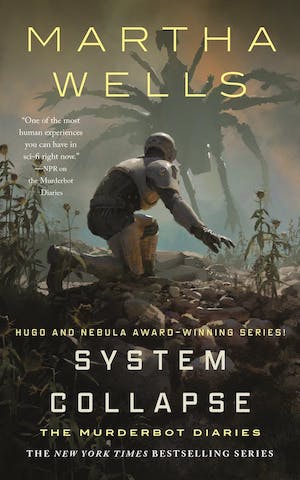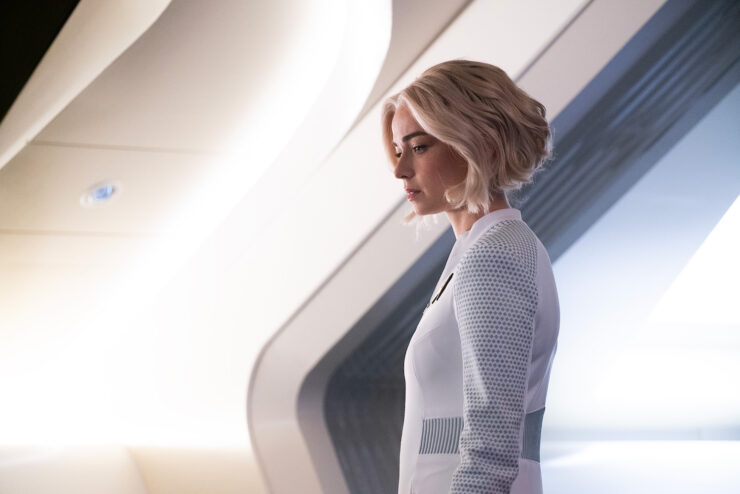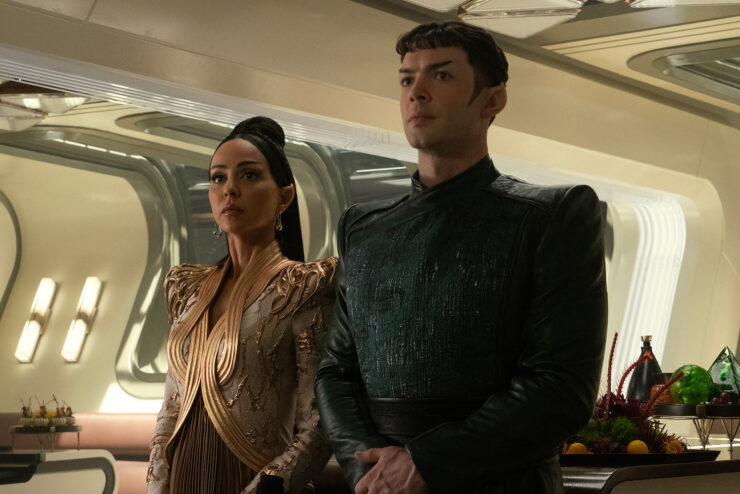During my Star Trek: Enterprise Rewatch, specifically that of the third-season episode “Extinction,” I mentioned what Jammer’s Reviews critic Jamahl Epsicokhan refers to as “Fun With DNA™” episodes. It usually involves a lot of nonsense science, oftentimes some silly acting, and commonly either a chance to put an actor not normally in prosthetics/makeup into such or an actor who normally has such to not have to deal with it. Among the other examples are TNG’s “Identity Crisis” and “Genesis” and Voyager’s “Threshold” and “Demon,” plus Discovery’s “Su’Kal” and “That Hope is You, Part 2” inverted the trope a bit.
Now we can add “Charades” to that list. This is not necessarily a good thing, though there are aspects of this episode that are quite compelling.
This episode, in which Spock’s DNA is altered so that he’s fully human, is a very obvious attempt to match the dynamic from last season’s delightful “Spock Amok.” At that, it fails pretty spectacularly, mostly because the script by Kathryn Lyn & Henry Alonso Myers keeps defaulting to sitcom silliness. (Given that Lyn came over from Lower Decks, where she wrote the excellent “wej Duj,” this is perhaps not a surprise.)
The actual Fun With DNA™ bit is not that bad, actually, and—ironically, given that it’s not the actual “comedy” part of the episode—provides the absolute funniest moments in this episode. Spock and Chapel go on a shuttle mission to examine some ruins. As we saw in “The Broken Circle,” Spock is still awkward around Chapel, given the feelings he has been having toward her, while Chapel is annoyed by Spock’s awkwardness, and who is also in the throes of the application process for a fellowship on Vulcan. While examining the ruins, they encounter an interdimensional rift, which damages the shuttle and injures them both.
Buy the Book


System Collapse
The interdimensional beings that live inside the rift are able to repair the shuttle and both occupants, but they notice that Spock doesn’t match Chapel, so they “fix” him and make him completely human. Pike tries to contact the aliens to get them to alter the repair, but the aliens—whom I was thinking of as the Customer Service Rep aliens pretty much from jump—hit Pike with all kinds of bureaucratic nonsense and make it clear they don’t want to talk to the icky outsiders anymore than necessary, and we did you a favor, and go away now please?
This leaves it to Chapel to find a cure. Meanwhile, Spock has to have dinner with his prospective in-laws, which—this being Vulcans—involves rituals and mind-melds and declarations of intent and all that good stuff. And this is where the episode goes off the rails. First of all, for all that it’s dressed up with traditional Vulcan foofaraw, this is basically just a “meet the future in-laws for the first time, but something goes wrong” plot, and Lyn and Myers have given us a tired mid-twentieth-century married couple with the overbearing mother T’Pril, who even makes T’Pring roll her eyes in frustration, and the henpecked father Sevet, who any time he expresses an opinion that differs from T’Pril, quickly changes his mind and does whatever his wife says after she glares at him and “corrects” him.
Because Spock is human now, he has to pretend to be Vulcan, getting fake ears and fake eyebrows put on, because T’Pril won’t accept anything else. But he also has to keep his human emotions under control, as he’s behaving almost like an adolescent. As an acting exercise for Ethan Peck, this has its moments—having met Peck at the Shore Leave convention in 2019, the Spock we see for most of this episode is pretty much Peck’s normal mode of talking—but it doesn’t entirely work. The episode itself acknowledges that Vulcan emotions are way more turbulent and difficult than human emotions, and Spock has spent his entire life suppressing his emotions. That’s a learned behavior, not a biological one, and it doesn’t make any sense that he’d have trouble keeping his emotions in check. However, he has to have that trouble in order to make the dopey sitcom plot work, as he contrives to “act Vulcan” in order to please T’Pring and her parents—who, of course, already disapprove of the half-human Spock.
And they also disapprove of Amanda. Mia Kershner is back, and while we are frustratingly denied the opportunity to see Amanda together with Carol Kane’s Pelia (Kane isn’t in the episode, with Pelia off trying to obtain some extra dilithium for some reason), I’m okay with it, because that would’ve been a distraction from some of what this episode does well. (Having said that, we’d better see Kershner and Kane together this season. That was promised when Pelia was introduced, dadgummit…)

Hilariously, given that the character herself was introduced in 1967’s “Journey to Babel” as little more than a housewife who deferred to her husband (a less comedic mid-twentieth-century stereotype than T’Pril and Sevet, but still sexist twaddle), this episode does a superlative job with Amanda Grayson. We see her strength, her resolve, her love for Spock, and also her love for Sarek (who of course isn’t in the episode, as we’re still in the midst of the twenty-year rift between Spock and Sarek established in “Journey…”).
The best part is the maternal mind-meld. Part of the ritual is that each mother must telepathically share a memory with their child. Amanda shares a remembrance of when Spock was accepted by other Vulcan children and allowed to play with them. This is a beautiful moment. Spock’s being tormented by full-Vulcan children for being a halfbreed is a well-established part of his character, seen in the animated episode “Yesteryear,” the 2009 Star Trek, and Discovery’s “Lethe” and “Brother.” But this shows us the next step: the eventual acceptance that he earned, and, more to the point, the pride Amanda felt. It’s obvious that Amanda respects a great deal about Vulcan culture—we see it all over the episode, in fact—but she is frustrated by many Vulcan people. But that scene shows us—and shows Spock—that it’s worth it in the end. It’s a beautiful moment.
Which is a relief after the nonsense that came before it. It’s frustrating, because Gia Sandhu remains superb as T’Pring, and Michael Benyaer and Ellora Patnaik deserve much better material as Sevet and T’Pril. So does Anson Mount. Pike is the host for the ritual—having even prepared Vulcan food, which everyone but T’Pril likes, because of course she doesn’t—and needs to come up with a delaying tactic at one point. The best he can do? A game of Charades. This gives the excuse for the title of the episode, which obviously has a layered meaning, since Spock’s being Vulcan for the ritual is a charade, as indeed is the entire ritual to a degree. But it’s just one more dumb thing in an episode full of them. Ha ha ha! The Vulcans have to play Charades! That’s funny!
One of the things I kept wondering last year is if this would be the episode where T’Pring and Spock had the rift that was evident in “Amok Time,” when it was clear that the affianced hadn’t spoken in ages. By this point, I had given up on seeing it any time soon, so it was a well-written surprise to see it happen here. T’Pring is not pleased that Spock didn’t trust her enough to tell her what happened to him. Spock made a judgment—an admittedly human one—that T’Pring was already stressed out from dealing with her mother and he didn’t want to add to it, so he let her think he was still Vulcan. T’Pring, justifiably, thinks they should spend some time apart.
Which leads us to The Kiss, and this is the bit that’s going to have a lot of Trek fans up in arms and babbling about “breaking canon” and saying this proves that SNW is in an alternate timeline, and all the same bullshit complaints we’ve been hearing about every single new production of this franchise since 1979. Because yes, Spock and Chapel smooch.
Here’s the thing: there’s nothing in the original series that contradicts any of this. In fact, the best proof of it is Chapel’s appeal to the Customer Service Rep aliens. Yes, as a human, Spock can probably more easily respond to Chapel and be a lover to her. But that isn’t Spock, it’s someone else. The person she actually is falling for is the Vulcan-human hybrid, with all the baggage that entails. That’s the tragedy of the pair of them that we did see in the original series, in “The Naked Time,” in “Amok Time,” in “Plato’s Stepchildren,” in “Return to Tomorrow.” It’s Spock’s cross to bear generally—we also saw it with Leila Kalomi in “This Side of Paradise”—that he cannot express his true feelings.
But that’s the Spock of seven-odd years hence. At this point, he still has had his emotional control frayed a bit from the events of “All Those Who Wander,” and then T’Pring left him, and Chapel has just spent a whole episode trying to save him. Oh, and the Customer Service Rep aliens also inform Chapel when she’s appealing to them to put Spock back the way he was that Spock shifted the shuttle’s shields to the side of the craft that Chapel was on so she would be less injured.

So she goes to his quarters and they smooch.
We know this will end badly, and the script reminds us of this during one of Chapel’s cramming sessions for her application for the fellowship. (Which she doesn’t get.) When her crewmates are quizzing her, one of the questions relates to Dr. Roger Korby, whom we know from the original series’ “What Are Little Girls Made Of?” will become her fiancé down the line. (And then get trapped on a planet and transfer his consciousness into a robot and try to kill Kirk and, yeah.)
Getting there, though, should be interesting. Certainly a lot more interesting than the Vulcan version of meeting the in-laws…
Keith R.A. DeCandido has stories in two new anthologies out now: Double Trouble: An Anthology of Two-Fisted Team-Ups, which he also co-edited with Jonathan Maberry, and which features team-ups of classic characters (Keith paired H. Rider Haggard’s title character from She with the Yoruba goddess Egungun-oya), with other contributors including fellow Trek scribes David Mack, Greg Cox, Dayton Ward, Derek Tyler Attico, Kevin J. Anderson, Diana Dru Botsford, David A. McIntee, and Rigel Ailur; and Sherlock Holmes: Cases by Candlelight Volume 2, which has four tales of Holmes & Watson by Keith, Christopher D. Abbott, and two more fellow Trek scribes Michael Jan Friedman and Aaron Rosenberg.










